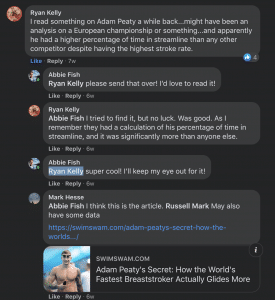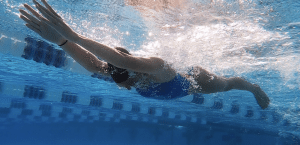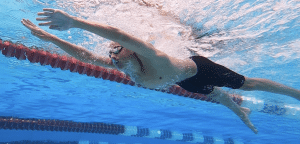I didn’t. I actually posted Part I of this series on the Swim Coaches Idea Exchange Group on Facebook and a guy named Ryan Kelly responded leading me down a wild goose chase to understand exactly what he read/meant. The short version of the matter is though – no matter what type of Breaststroker you are – every BEST Breaststroker out there, hits their body line.

Let’s get started!
If you missed Part I or Part II of this series, click the respective links to catch up: Part I and Part II. If you’re ready to rock and roll – let’s do this.
What is YOUR Body Line?
Your Body Line is what I call the streamline (well, almost) streamline position you hit at the very END of your glide – right before your next stroke in Breaststroke. The only difference between this position and a streamline is your wrists are not on top of each, but rather side by side – see below:

Your Body Line is important, as it’s a very hydrodynamic position for a swimmer. There is a low drag coefficient associated with it and you are surging forward from the help of the kick just finishing up on the back end. If you don’t allow yourself time to hit that line (even if it’s just for a brief moment), you will end up in a star fish position – where your feet are still snapping together, but your hands have already opened up, up top. See below:

Hitting YOUR Body Line in Breaststroke is NOT Easy:
To hit Your Body Line consistently, you have to hold your breath. And that breath hold is LONGER than you would hold it, otherwise. Now this might initially not make sense, because for those of you remember Part I and II of this series – you now know there’s 2 main ways to swim Breaststroke: DPS Stroke and Fast Recovery. It doesn’t really matter which stroke you use — since the recovery speed is the main variation between the two — but if you compare the amount of TIME spent in each stroke style: DPS or Fast Recovery, if you hit your Body Line — you will end up spending MORE time with your head down, than if you did not.
That’s what I didn’t understand.
Here’s the article that Ryan Kelly was talking about. It’s titled How the World’s FASTEST Breaststroker Actually Glides More. It’s brilliant and very click-baity. Essentially, this article analyzed Adam Peaty’s stroke and broke down both his kick and pull into 4 and 3 phases, respectively. What they did was then analyze how much time he spent on average in each of these phases and it came out compared to other parts of his pull – Adam spent the most time in the ‘Passive Phase’, which they consider the glide. I really enjoyed this article and it had some neat points, but just like ANY research article – you have to look at the details.
The ‘Passive Phase’ is by definition the phase from the end of the recovery to the catch of the next pull. This is where the data can be skewed — depending on how you look at it. For me, I’d consider the start of the hands pulling backwards as part of the pull, even with knowing you’re not generating a ton of propulsion there. So since, they add a ¼ or so time onto the glide phase, than I would have done – it came out as titled: Adam Peaty actually glides MORE than any other Breaststroker.
If you redid the math with the same numbers: Propulsive: .38 seconds, Recovery: .27 seconds, and Glide: .48 seconds – but took that ¼ extra time away from the ‘Passive Phase’ and put it back into the ‘Propulsive Phase’ – you’d end up with: Propulsive: .50 seconds, Recovery: .27 seconds, Glide: .36 seconds. Show that Adam spends about the same amount of time not breathing, as he does breathing!
What Does This Mean for Me?

That Breaststroke is a KICK-DRIVEN stroke. You can only increase your tempo, based off of how fast you can get your feet TO and THROUGH the next kick. For someone like Adam Peaty who swims with a Fast Recovery stroke and a tempo of 55+ strokes per minute, he does NOT skimp on his glide and neither should you.
In order to be able to swim at this stroke rate, Adam has had to TRAIN with minimal oxygen. Adam has had to make the intention of understanding that swimming Breaststroke FAST means he’ll be running out of oxygen and very uncomfortable — as he knows the quickest way is to HIT his body line every time!
While gliding LONGER (at first) may seem slower, it actually is NOT. Rushing into your next stroke will NOT make you faster, because you’ll hit that starfish position and have so much frontal drag coming at you – it’ll cancel the help your legs are trying to do for you on the back end.
Breaststroke is the MOST technique-oriented stroke – in my opinion. I remember long-time friend and Olympian in the 2012 games, Clark Burckle, telling me at practice one day, “Breaststroke is a stroke that requires some finessing. You can’t rush it, or it screws up your stroke entirely.” I couldn’t have said it better myself.
Until Next Time,
Abbie Fish

6 Responses
Many moons ago Breastrokewas simple – the British were core driven (thru the wave), the Japanese were legdriven (under the wave) & the Koreans were shoulderdriven (over the wave)
According to your strengths you swam Breast – under, over or thru the wave)
Yep 🙂
“If you redid the math with the same numbers: Propulsive: .38 seconds, Recovery: .27 seconds, and Glide: .48 seconds – but took that ¼ extra time away from the ‘Passive Phase’ and put it back into the ‘Propulsive Phase’ – you’d end up with: Propulsive: .50 seconds, Recovery: .27 seconds, Glide: .48 seconds. Show that Adam spends about the same amount of time gliding as he does pulling — meaning he’s holding his breath more often than he is actually breathing!”
Not to quibble, but you add 0.12 seconds to the propulsive phase but fail to deduct it from the glide. Shouldn’t it be .5P/.27R/.36G? If so, how does this change your analysis? One might argue that the breath starts nearer the catch, rather than immediately upon the separation of the arms, and therefore the original .38 value for propulsion + .27 for recovery better measures breathing time. This, in turn, would mean that Peaty’s time w/ the face out of the water (.54) is roughly equal to that spent face-down (.48). Not as bold a statement, perhaps, but perhaps a more accurate one and still enough to support your conclusions that follow.
Good eyes! Totally missed deducting that value, but still doesn’t change the findings…because it’s only during the propulsive phase that they swimmer breathes, so even with their head out of the water (literally) more than in — you can combine the .27 (recovery value) + .36 (glide value) and they are STILL spending more time not breathing, than breathing! Appreciate your comment though.
Abbie — I LOVE this! I can’t wait to read the article and hear more in the webinar. This is why I love breaststroke — it is a complex and fascinating stroke. 🙂
It is definitely the most technical of strokes FOR SURE. Thanks so much for the kind words and comments!